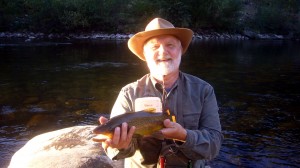With all the rain these days, I find it a good time to start getting my equipment ready for the upcoming season. There is nothing more important than our boots when it comes to fishing and protecting our rivers.
Boots: The New Zealand mudsnail has been discovered in the Yuba. It has been in Putah Creek for years and is causing great damage to the food production habitat. Currently we do not have the mudsnail in the Middle Fork. We want to keep it that way. If you fish any of these rivers you have two choices. The first is have a set of boots for the Middle Fork and one for rivers that contain the mudsnail. The other way is to freeze your boots in a plastic bag overnight after fishing the Yuba or Putah Creek. Please make sure your guests follow the same practice to protect our river. Here is an example how this snail can cover the river bottom and prevent our natural bugs from reproducing.
Fly Line Care: When was the last time you changed or washed your fly line? We all want our lines to float high in the water to prevent the dry fly from being pulled under. A dirty line will cause the line to sink. Here is a link to a Rio video that explains how easy it is to clean and protect your line so that it remains high in the water. http://www.rioproducts.com/fishing-tips/cleaning-fly-lines/
Rods: Periodically wax the ferrules (where the rod pieces separate) lightly with paraffin to ensure a firm fit and proper function. Completely air dry your rod and place it in a cloth bag and tube before storing. The rod tubes can trap moisture, which can swell reel seats and ruin the rod finish. To protect the tip, it is best to bag your rod with the tip top and cork handle up. Occasionally clean your rod with warm water and soap and completely dry. To shine, apply furniture polish and don’t forget to protect the rod when finished.
Reels : Reduce the drag pressure to the lowest setting when the reel is not in use, and store in the neoprene reel case away from extreme heat. Clean the reel by rinsing with cool fresh water and dry. Take care to thoroughly remove all sand and grit from the reel. Leave the frame and the spool apart and dry completely out of the reel case. After use in saltwater, pay special attention to cleaning the reel, as saltwater can leave a sticky residue that will harden over time if not properly cleaned and dried.
Fly Boxes: Some people like to have both dry and wet flies in the same fly box. Others prefer to have a box of dry and a box of wet flies. To each his own. When I look at my cupboard I get overwhelmed at the number boxes and flies I have I probably have over 5000 flies yet I would be surprised if I use 100 different flies each year. We have all stopped by the local fly shop when on a trip and sought advice and purchased a handful of the recommended flies. I rarely use more than a few of the flies I purchased, but figure I help keep the shop open. Now is a good time to reorganize your flies and boxes. It has been suggested that we keep a mothership of flies and then have a day on the water box for flies I intend to use. Others suggest that you set up specific boxes for your destinations. If you are a shad fishermen it is nice to have a dedicated Shad fly box. If you like to swing flies, having a box of leaches and streams comes in handy. Same goes for nymphs and dry flies. I have a boxes for terrestrials, Ants, hoppers, etc that act as my mothership. Now is a good time to gather all your flies and organize them in a manner that you feel comfortable. This saves a lot of time when you are ready to go fishing.
Vests vs packs: For many years I used a vest and carried enough stuff in it to open a small fly shop. After a while I noticed it weight ten pounds and I rarely used 95% of what the jacket held. This is a good time to wash your vest and go through the pockets to make sure what you need is there and what you won’t use is removed. The same goes for chest packs. I keep adding stuff to my chest pack that I really do not need. How many time do you need a tool to tie a nail knot on the river? That is a tool that can be kept in your wet bag. My wet bag has more gear in it than a small fly shop. The good thing is that it is left in the car or boat while I fish.
Waders: When was the last time to washed your waders. Did you ever fix that pinhole in them that annoyed you every time you were on the river. Now is a great time to wash and repair and leaks in our waders : Here are some suggestions from Simms.
Wader Care & Maintenance
Waders should be washed by hand, in a bathtub, in cold water using a powder detergent. Rinse thoroughly and allow to air dry, including the feet. Packaging or storing your waders wet may result in mildew and tape peeling. Simms Waders should not be dry-cleaned or put in the dryer. A water repellent treatment, such as Revivex�, will rejuvenate the water resistant finish on your waders.
Applying Water Repellent Treatment
After the waders are washed and thoroughly rinsed, saturate the outside of the waders with Revivex� or other water repellent treatment. Allow product to drip-dry. “Set” the treatment with heat using a blow dryer or iron (low setting), avoiding the stockingfoot attachment area.
Repairing Your Simms Gore-Tex Waders
Tears, punctures and pinholes do happen. Luckily, Gore-Tex� waders are easy to repair. 1) Turn waders inside out. 2) Apply rubbing alcohol to suspect area. Leaks will show as dark gray spots. 3) Immediately apply AquaSeal� to the area and cure for six hours. Please note: this method will not work on seam leaks. If you think you have a seam leak, call 406-585-3557 for information on returning your waders for repair.
I hope this helps you get your gear in shape and ready for a great season of fishing the Middle Fork at the club.
Tom Bartos
President & Founder


Leave A Comment
You must be logged in to post a comment.